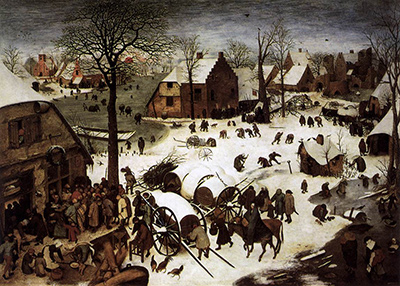Pieter Bruegel the Elder, was a prominent Flemish Renaissance artist who pioneered the genre art with his paintings of peasants.
His detailed depiction of the everyday lives of peasants at a time when this was not popular earning him the nickname, Peasant Bruegel.
At a time when Italian Renaissance arts reigned supreme to Northern Renaissance art, Bruegel maintained an independent style that was unconventional both in subject matter and style.
In The Census at Bethlehem, Bruegel’s adroit brushstrokes reference the Bible in a contemporary style.
Bruegel paints what would have been the street view of Bethlehem during the caesar's sanctioned census.
A brave departure from the norm, Mary and Joseph are not the paintings' central point of interest; they are amidst an activity filled street. The Census at Bethlehem may pass for a nativity painting but remaining true to Bruegel; a closer inspection reveals much more.
At the core of the painting, however, redemption rings loud.
Using a muted green and an assortment of browns, Bruegel a resident of Antwerp depicts a scene which is very much like the Low Countries of Europe in architecture and dressing.
A keen observation of the Census of Bethlehem brings to mind the widely popular Hunters in the Snow, whose rich scenery and detail accentuate Bruegel's talent.
Interesting to note, he would on occasions dress as a peasant to blend in with the masses which enabled him to observe their mannerisms in great detail evident in his other works such as, The Peasant Weeding and Netherlandish Proverbs.
Bruegel's influences included Hieronymus Bosch; Bruegel is noted as Bosch’s avid follower as evidenced in his early works. The sculptor, painter, and author, Pieter Coecke van Aelst was his master and later father in law.




